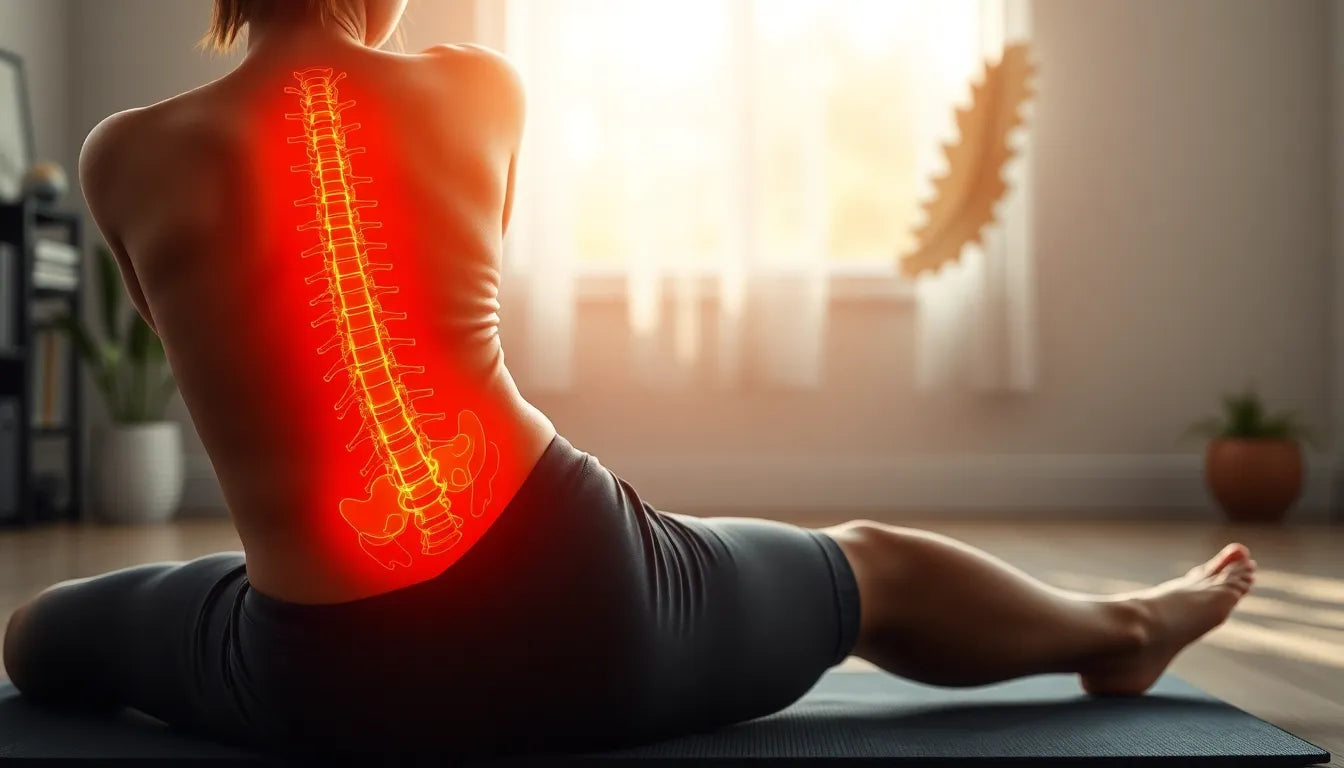Throbbing back pain is a common ailment that can disrupt daily life, causing discomfort and concern for many individuals. This type of pain is characterized by a rhythmic pulsing or beating sensation in the back, which can vary in intensity and duration. Understanding the nature of throbbing back pain is crucial in determining the appropriate treatment and management strategies.
Understanding throbbing back pain
Back pain, in general, is a prevalent issue that affects a significant portion of the population at some point in their lives. It can manifest in various forms, such as sharp, shooting, stabbing, or aching sensations. Throbbing back pain specifically refers to a pulsating feeling that can be both physically and mentally taxing. This type of pain can range from mild to severe, potentially impacting an individual's ability to perform everyday tasks.
The prevalence of back pain highlights the importance of identifying the specific characteristics of the pain experienced. By understanding whether the pain is throbbing, sharp, or dull, individuals can better communicate their symptoms to healthcare providers, leading to more accurate diagnoses and effective treatment plans. Recognizing the nature of the pain can also help in determining whether it is a temporary discomfort or a sign of a more serious underlying condition that requires medical attention.
Common experiences and concerns
Individuals suffering from throbbing back pain often report a wide range of experiences. The intensity of the pain can fluctuate, sometimes becoming more pronounced during certain activities or at specific times of the day. This variability can lead to significant discomfort, affecting one's ability to engage in work, exercise, or leisure activities. Moreover, the persistent nature of throbbing pain can contribute to stress and anxiety, as individuals may worry about the potential causes and implications of their symptoms.
Common concerns among those experiencing throbbing back pain include fears of underlying serious conditions, such as spinal issues or organ-related problems. The uncertainty surrounding the cause of the pain can lead to apprehension about whether medical intervention is necessary. It is essential for individuals to be aware of the potential causes and risk factors associated with throbbing back pain, as well as the red-flag symptoms that may indicate the need for urgent medical care.
Overall, understanding the nature and implications of throbbing back pain is a crucial step in managing and alleviating the discomfort it can cause. By recognizing the common experiences and concerns associated with this type of pain, individuals can take proactive measures to seek appropriate care and improve their quality of life. In the following sections, we will explore the causes, risk factors, and self-care strategies that can help in finding relief from throbbing back pain.
Causes of throbbing back pain
Understanding the root causes of throbbing back pain is essential for effective management and treatment. This type of pain can arise from various sources, each requiring different approaches to relief.
Muscle or ligament strain
One of the most common causes of throbbing back pain is muscle or ligament strain. This can occur due to heavy lifting, sudden movements, or maintaining poor posture for extended periods. Such activities can overstretch or tear muscles and ligaments in the back, leading to inflammation and the characteristic throbbing sensation. Ensuring proper lifting techniques and maintaining good posture can help prevent these strains.
Spinal issues
Spinal problems, such as disc herniation or spinal stenosis, can also lead to throbbing back pain. A herniated disc occurs when the soft inner material of a spinal disc leaks out, irritating nearby nerves. Spinal stenosis involves the narrowing of the spinal canal, which can compress the nerves. Both conditions can cause pain that radiates through the back and may be accompanied by numbness or weakness in the legs. These issues often require medical evaluation and specific treatment plans.
Organ-related conditions
Sometimes, throbbing back pain can be a symptom of an issue with internal organs. Conditions such as kidney infections or stones can refer pain to the back. In such cases, the pain is often accompanied by other symptoms like fever, nausea, or changes in urination. It is crucial to seek medical attention if you suspect an organ-related cause of your back pain.
Inflammatory or systemic conditions
Inflammatory conditions, such as arthritis, infections, or autoimmune disorders, can contribute to throbbing back pain. These systemic issues often cause widespread inflammation, affecting the joints and tissues in the back. Managing these conditions typically involves a combination of medication, lifestyle changes, and sometimes physical therapy.
Risk factors and red flags
Common risk factors
Several risk factors can increase the likelihood of experiencing throbbing back pain. Age is a significant factor, as the spine undergoes degenerative changes over time. Obesity can also contribute to back pain by placing additional stress on the spine. Physical inactivity, improper lifting techniques, and psychological stress are other common risk factors that individuals should be aware of.
When to seek emergency care
While most cases of throbbing back pain are not emergencies, certain symptoms may indicate a more serious condition that requires immediate medical attention. These include radiating pain, numbness, leg weakness, or incontinence, which could suggest nerve compression or cauda equina syndrome. If you experience any of these symptoms, it is important to seek medical care promptly to prevent further complications.
Self-care and management strategies
Initial self-care
For many individuals, initial self-care measures can effectively alleviate throbbing back pain. Resting the affected area, applying ice or heat, and taking over-the-counter pain relief medications can help reduce inflammation and discomfort. Gentle exercises, such as stretching or walking, may also aid in recovery by improving flexibility and circulation.
The role of ergonomics
Ergonomics plays a crucial role in preventing and managing throbbing back pain. Using ergonomic aids, such as supportive chairs, standing desks, or lumbar cushions, can help maintain proper posture and reduce strain on the back. Incorporating ergonomic principles into daily activities can significantly lower the risk of developing back pain related to posture and repetitive strain.

Lumbar support belt
Adjustable back belt that combats lower back pain and provides relief whether sitting or active.
By understanding the causes, risk factors, and self-care strategies for throbbing back pain, individuals can take proactive steps to manage their symptoms and improve their quality of life. In the next section, we will discuss long-term management and prevention strategies to help maintain a healthy back.
Long-term management and prevention
Effective management of throbbing back pain requires a combination of lifestyle modifications and preventive measures. By adopting healthier habits and utilizing ergonomic solutions, individuals can significantly reduce the risk of recurring pain and improve their overall well-being.
Lifestyle modifications
Maintaining a healthy lifestyle is crucial in managing and preventing throbbing back pain. Regular physical activity strengthens the muscles supporting the spine, enhances flexibility, and promotes better posture. Activities such as swimming, yoga, and walking are particularly beneficial as they are low-impact yet effective in maintaining spinal health.
Additionally, managing stress through relaxation techniques like meditation or deep-breathing exercises can help alleviate tension that contributes to back pain. Maintaining a healthy weight is also vital, as excess body weight can place additional strain on the spine, exacerbating pain.
Ergonomic solutions
Incorporating ergonomic solutions into daily routines can significantly reduce the risk of developing throbbing back pain. Ergonomic products, such as adjustable chairs, standing desks, and lumbar supports, help maintain proper posture and minimize strain during work or leisure activities. Ensuring that workstations are set up ergonomically can prevent back pain related to prolonged sitting or repetitive movements.

Men's Posture Shirt™ - Black
Støtter og aktiverer rygmuskler, kan lindre spændinger og forbedre kropsholdning.
Furthermore, practicing good posture and using proper techniques when lifting heavy objects can prevent muscle strains and other injuries that lead to throbbing back pain. By making these adjustments, individuals can create a more supportive environment that promotes spinal health.
Conclusion
Understanding the causes and management strategies for throbbing back pain is essential for finding relief and preventing future occurrences. By recognizing the symptoms and risk factors, individuals can take proactive steps to address their pain and seek medical attention when necessary. Implementing lifestyle changes and ergonomic solutions can further enhance long-term back health, ensuring a more comfortable and active life.
Frequently Asked Questions
What is the difference between throbbing and other types of back pain?
Throbbing back pain is characterized by a rhythmic pulsing or beating sensation, which is distinct from sharp or shooting pain that may indicate nerve involvement. Understanding the type of pain experienced can help in determining the appropriate treatment approach.
How can I tell if my back pain is serious?
Serious back pain is often accompanied by red-flag symptoms such as severe pain with leg weakness, numbness, or incontinence. These symptoms may indicate conditions like nerve compression or cauda equina syndrome, requiring immediate medical evaluation.
What are the best exercises for relieving back pain?
Gentle stretching, yoga, and low-impact activities like swimming are effective in relieving back pain. These exercises help improve flexibility, strengthen supporting muscles, and promote better posture, all of which contribute to reducing pain.
Can ergonomic products really help with back pain?
Yes, ergonomic products are designed to support proper posture and reduce strain on the back. By incorporating these products into daily routines, individuals can prevent and alleviate back pain, particularly those related to poor posture and repetitive strain.
When should I see a doctor for my back pain?
If back pain persists beyond a few weeks, worsens, or is accompanied by alarming symptoms such as numbness or leg weakness, it is important to seek medical advice. Early intervention can prevent further complications and ensure effective treatment.
Källor
- Cleveland Clinic. (n.d.). "Back Pain: Symptoms & Causes." Cleveland Clinic.
- Mayo Clinic Staff. (n.d.). "Back Pain: Symptoms and Causes." Mayo Clinic.
- UT Southwestern Medical Center. (n.d.). "5 Signs Your Back Pain Might Be an Emergency." UT Southwestern Medical Center.
- American Dental Association. (n.d.). "Symptoms and Causes of Back Pain." American Dental Association.
- Hospital for Special Surgery. (n.d.). "Lower Back Pain: In-Depth." Hospital for Special Surgery.
- MedlinePlus. (n.d.). "Back Pain." MedlinePlus.
- Stanford Medicine. (n.d.). "Low Back Pain." Stanford Medicine.
- Mount Sinai. (n.d.). "Low Back Pain - Acute." Mount Sinai.
- MyHealth Alberta. (n.d.). "Back Pain." MyHealth Alberta.


















